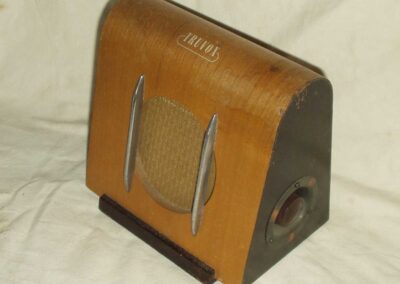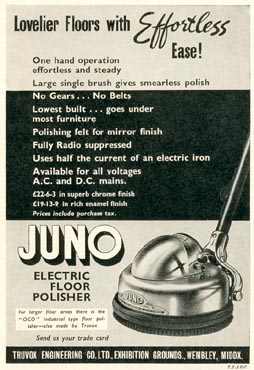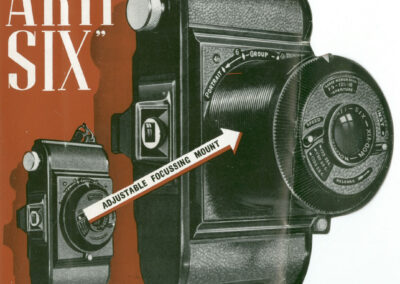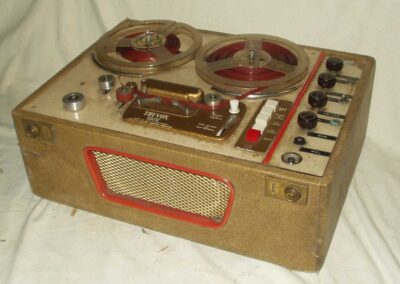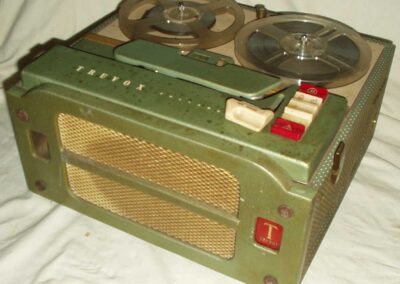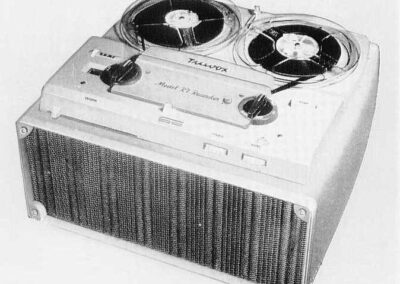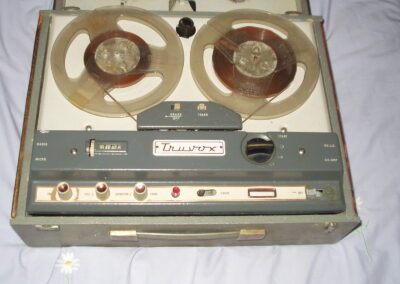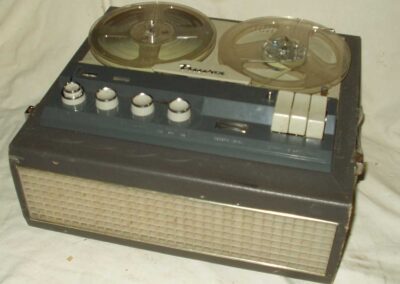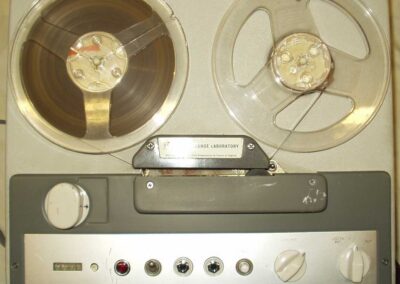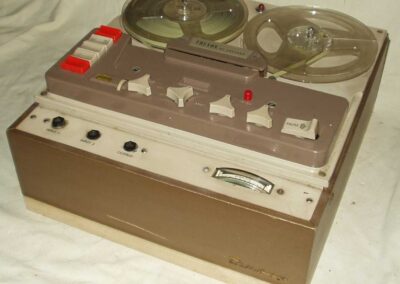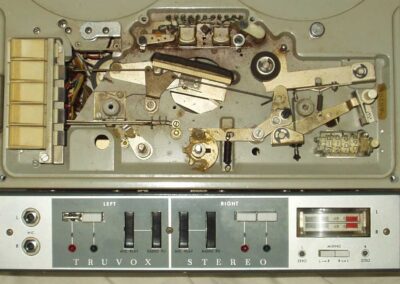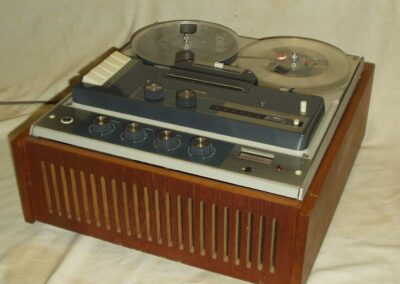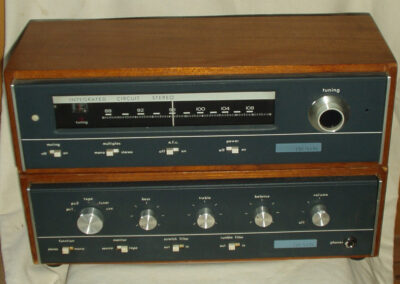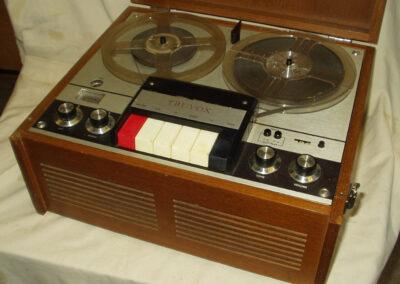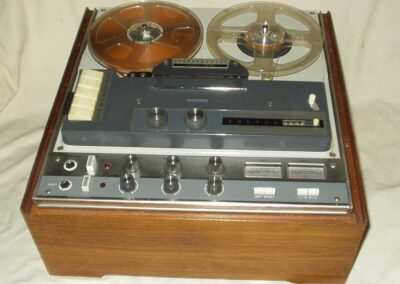The formative years of Truvox are still unclear, suffice to say the business was founded by Daniel Dan Prenn, whose first business in Britain was assembling fountain pens. It appears he may have bought a ready-made company, Truvox Ltd, formed in October 1928, and the Universal Radio & Gramophone Co, of Kentish Town, from where Truvox originally operated. His more famous Truvox Engineering Ltd business was formed in June 1936.
Daniel Dan Prenn was a Byelorussian-Jew who studied civil engineering in Germany and became a world class, top-seeded, tennis player representing Germany in the Davis Cup during the 1930s before being exiled under the anti-semetic Nazi regime, fleeing to Britain in 1933. Later, as a prominent Jewish businessman, he nurtured other small Jewish- refugee businesses and over the next 50 years created one of Britain’s largest military electronics and communications ’empires’ through the merger of his Thermionic Products business with Racal Electronics, while his family-run Truvox Floorcare business became a leader in its own right. The full story is told in “A Truvox Product”.
Loudspeakers
Prenn launched a series of ‘Truvox’ loudspeakers in the 1930s, of which little is known (can anyone help?) ranging from miniature 3″ to auditorium units, as well re-entrant public address speakers. Then in 1937, Truvox moved to the redundant Wembley Exhibition grounds and during the war produced thousands of ‘Tannoy’ type artillery loudspeaker-telephone sets for the forces.
Truvox’s major competitors were Tannoy, Goodmans, Celestion and Rola, but when the Anglo-American Rola-Celestion business faced a serious financial crisis in 1949, Prenn bought their British operations and merged it with his Truvox speaker business. Truvox’s few post-war enclosed speakers included the ‘Model 55’ extension speaker intended for radios or office dictaphones; it incorporated a volume output control. While the group’s domestic hi-fi speakers were now dominated by ‘Celestion’ models, such as the famous ‘Ditton’, their public address speakers were generally branded ‘Truvox’, but in 1964 Truvox launched their new TS100 and TS200 enclosed speakers to complement their Series 100 and 200 tape-recorders and tuner-amp range using Celestion cones but, after Celestion left the group in 1969, a new LS300 briefly appeared with KEF cones. Either way, their speakers maintained Truvox’s high fidelity credentials.
BCC
Just after the war, Prenn bought the fledgling British Communications Corporation and rapidly expanded their new walkie-talkie operations into a major Army and Police mobile radio-telephone and lifeboat communications business. They expanded into airfield voice-loggers in 1956, and poached Konrad Short from Truvox to lead its development, but Konrad soon left to form Record Devices Ltd. With Thermionic Products (and their parent Pena Group) now in financial trouble, Prenn bought Thermionic Products to which he transferred BCC’s airfield voice logging business to allow BCC to concentrate on military back-pack communications. (The proposed ‘Clansman’ military back-pack contract led to their merger in 1969 with Racal Electronics). In taking over Thermionic Products, Prenn passed the business to his Controls & Communications Ltd (the former Radio & Television Trust with its famous ‘Philco’ and ‘Airmec’ interests, of which Prenn had gained control).
Floor care
During the war, Truvox had been developing plastic extrusion technology and it appears very briefly offered a gramophone pick-up in 1947. They also briefly produced simple license-built Bakelite bodied cameras and electrical appliances between 1950 and around 1955 but more importantly had taken over production of a German floor cleaner machine. How this came about is still unclear, but Prenn’s Truvox Floorcraft business became a significant part of his empire and remained in the family’s hand when it split from the audio/electronics side in 1969. Truvox International floor care survives today as a world leading floor-cleaner and maintenance manufacturer, albeit now part of an American group.
Tape-recorders
Immediate post war patents show that Truvox were taking an interest in the Recordon type magnetic oxide disc recorder but the break-through came in when 1951 when Truvox developed a 7″ domestic tape deck intended for cabinet-makers to install into radio-grams. Much work on this, including heads, was by Konrad Short. Uniquely, it used a 3/8″ furniture grade plywood deck, faced with a Formica laminate and conductive aluminium film to which was bolted a cast-alloy head-block and flywheel/motor cradle. Switchgear, with electrical braking, was in a separate block. As with the later Brenell, capstan sleeves determined tape speeds but unlike many British and American decks, Truvox used the German right-to-left, upper track format.
Launched in late 1952, and marketed through Rola–Celestion, the tape deck underwent several minor improvements to soon become a major force in DIY tape-recorders; they soon offered an impressive range of accessories, including their famous ‘Radio-Jack’ plug-in MW/LW crystal radio receiver. They launched their first tape-deck amplifier in 1954 from their new factory at Neasden, and then adopted the British/US tracking format (but still right to left transport) launching in 1956 the more compact Mk.III TR7/U deck, with its gold livery, reducing the width by a couple of inches. The Mk.III proved very popular with other tape-recorder companies and High Street Hi-Fi dealers for the DIY enthusiasts, and survived until 1957 when it was superseded by the new Mk.IV deck.
R1
Truvox’s first complete tape-recorder, the R1, used what became known as the MK.IV deck. Launched in Spring 1956, this improved Mk.III based deck had new, stylish cast-alloy head-covers and was also offered for DIY or original equipment fitting, complete with the new Truvox ‘K’ Type amplifier, in a range of specifications. The R1’s deck and amp were mounted within a cradle which slid into the plywood cabinet. An improved R2 followed and was joined by their first ‘Twinset’ stereo model, using their own heads and a matching R2 case for the second channel amp and speaker.
R6
In 1959, a more modern looking R6 arrived using a modified deck (christened the MK.VI – there was no Mk.V), now with its keyboard controls on the left hand side and the standard left to right transport, upper track format. It had a striking, slanted front speaker grille and remained on sale alongside their entirely new R7 auto-reverse and then briefly with the greatly improved, cast-alloy deck Series 80.
Auto-reverse
The R7 auto-reverse was launched in September 1959. Built to demanding hi-fi standards, it was completely different to their previous models, using a single, pole-switching reversible capstan motor with pairs of heads ranged either side. Its 10watt amplifier and electronics gave superb reproduction, but while aimed at the discerning audiophile, and pitted against the Simon SP4, the Truvox R7 was over-priced and consequently few were sold; it was eventually withdrawn in 1964 and is now incredibly rare.
Lo-fi
Meanwhile in 1958, Prenn had come to the aid of a fellow businessman to market a pair of end-of-the-line Italian made ‘Incis’ models, the 4″ Melody and 5″ Harmony – both were pretty mundane, uninspiring and soon forgotten: thankfully they did not carry the Truvox name. But in 1960 Truvox launched a new Series 60 budget model using the same Incis deck as the Elizabethan LZ27. It survived into 1962 and was equally unimpressive. Unfortunately, Truvox then returned to the budget market in 1965 with the new Magnavox 363 deck for their Series 40. The deck was the result of the recently merged Magnavox and Collaro companies, designed to offer great versatility and potential for modification, but alas its build quality was lacking, as too was Truvox’s early transistor technology. No sooner were these cured than Magnavox ceased production in 1967. As the 363 deck had also been chosen by several other companies, legend has it that Truvox bought the remaining stocks and design rights to ensure the Series 40’s continued production.
Series 50
In 1967, Truvox’s lease at Neasden expired and Prenn then merged Truvox with Thermionic Products. moving production to Hythe, where the new Series 50 was first produced, replacing the Series 40. The promising mono Series 50 was built to hi-fi standards using a single motor drive which, with its twin hi-fi speakers, Marriott heads, DIN socketry and a central piano-key operation (much like the hugely successful Thorn decks) was aimed at the discerning domestic user. It came in a high-grade teak veneered cabinet (the carrying handle in the photograph is not correct), or in ‘ruggedised’ form for education authorities as a less expensive alternative to their popular Series 100. But despite its hi-fi credentials, the Series 50 failed to make significant sales, hardly denting market share held by the Thorn group and the new Japanese competitors so when Racal and Thermionic Products merged in 1969, the Series 50 was immediately dropped.
Language laboratories
Truvox was approached by The Rank Organisation in 1963 to produce for them a suitable language laboratory student deck. While their Series 80 was fine as a ‘master deck’, the unique student deck need only be a simple affair for merely listening to one track and recording simultaneously on the other. Designed in association with Raymond Hart Associates and Truvox’s Ron Bishop, several went to the RAF in Germany and British universities. Truvox duly won a contract to supply EBEN of Germany with standard decks and soon gained a major share as master decks for the British language laboratory market.
Hi-Fi – Series 80 and 90
So successful had the Mk.III/Mk.VI Truvox deck become that in 1961 it was re-engineered by Ron Bishop using a new cast-alloy deck to allow head-on competition with their European competitors – Truvox was a keen exporter. His new 2-speed Series 80 was offered in a fawn/cream livery in either 1/2 or 1/4-track format as a transport deck (D82 etc), plinth mounted recorder (PDxx), or complete tape-recorder with output amplifier (Rxx). A highly praised stereo model, the PD86/R86, came in March 1962. These were superseded by a Mk.II range in October with the Papst hysteresis capstan motor and 3-speed operation but, confusingly, they kept the same model numbers!
Unfortunately the cast-alloy deck prevented its modification to 10-1/2″ for professional users. Never-the-less, the Series 80 proved to be a most robust and reliable deck and soon endeared itself to education authorities – indeed by the mid-1960s, Truvox were dominating that market, especially as master decks for the demanding new language laboratories.
The valved Series 80 was greatly improved in 1963 and re-launched as the Series 90, now with pcb technology, VU meters and a new blue-grey livery. Their tape-recorders were now housed in an attractive, robust plastic and plywood case with honeycombed grille, later adopted by the Series 40. The stereo PD86 with its twin VU meters further enhanced Truvox’s reputation for quality, even if the one piece head pressure pad left much to be desired. This would be their last valve model.
Transistors – Series 100 and 200
In 1963, Ron Bishop designed and launched Britain’s first transistorised hi-fi amplifier, just beating Leak. The TSA100 was intended for the new, transistorised Series 100 tape-recorder. The amplifier was very highly regarded for having retained the unique ‘valve’ sound. Housed in a quality teak veneered case, it was joined by a matching FM100 FM tuner, capable of being upgraded to stereo, and in 1965 the de-luxe teak veneered Series 100 ‘Belgravia’ tape-recorder and the LS100 speaker. With the launch of the Series 200 in 1969, the tuner and amplifier were upgraded to the TSA200 and FM2001C stereo tuner, now in a new blue-grade livery.
The new Series 100 set even higher standards for robustness, ease of use and sound quality than the Series 90. It now had a professional, suspended Bogen head set-up, Papst capstan motor and British EMD spool motors. Its audio capabilities matched those of their domestic Brenell and Ferrograph competitors. Yes, it was a very fine machine indeed but, unfortunately, the move to Hythe led to a temporary loss of production which allowed Tandberg to increase its position in Truvox’s crucial education/language laboratory market. Worse, Philips’ Compact Cassette was eroding the open reel market, now increasingly dominated by the Japanese. Unlike Brenell and Ferrograph, Truvox could not modify their cast alloy deck for the 10-1/2″ professional market and, frankly, it would be pointless making a major new investment in a new design. Never-the-less, the Series 100 was upgraded to the new Series 200, benefiting greatly from Thermionic Product’s military contract quality control expertise.
The Series 200 was arguably their best ever deck (the stereo example shown in the photo is a factory pre-production model) and was proudly launched in February 1969 with the slogan: “This won’t be the first tape-recorder you’ll own. But it could be the last”… and sadly for Truvox, it was, for when Racal and Thermionics merged later in 1969 to concentrate on military electronics, interest in the Truvox audio equipment side abruptly ended and production of all but the 200 deck came to an end in September 1970, after which the deck was modified as the 4-speed Racal-Thermionic T3000 portable instrumentation deck (at £600 vs £125 for the domsetic-user Truvox 200) only to be replaced in 1970 by the incredibly versatile Store 4 (see Thermionic Products).
“A Truvox Product”
150pp, 200+ b&w illust A4 p/b (c) 2006, 2007, 2011, 4th edition 2016
“Diligently researched; a fascinating story of human endeavour; an interesting insight into success and disappointment.” D Ezekiel, Truvox Financial Director

